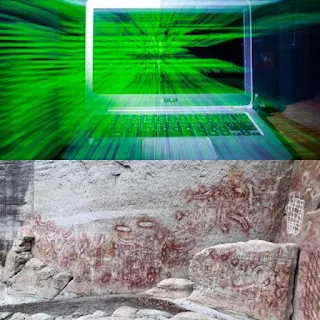Scientists have discovered unique prehistoric rock art drawings in Andriamamilo Cave, western Madagascar.
The prehistoric cave drawings are considered "unique", as they are the first true work of art, depicting local nature in forms resembling humans and animals, as until recently, rock art in Madagascar only showed a small number of sites that depict merely basic symbols. .
The exciting discoveries included many surprises, including hints about some fascinating cultural connections:
-First: The scenes depicted are in some cases somewhat directly related to Egyptian religious motifs from the Ptolemaic period (300-30 BC).
-Second: Other conclusions from the symbols and graffiti showed connections to the Ethiopian and Arab-African worlds.
-Finally: The prevailing symbols and motifs evoked the two-thousand-year-old cave art style of Borneo.
There are also other surprises, such as the depiction of at least three extinct animals in Madagascar (believed to have been extinct for many centuries): the giant sloth lemur, the elephant bird (a large, flightless species of birds), and the giant tortoise.
It has long been believed, and evidence confirms, that the people, language and culture of Madagascar are rooted in distant ancient links with Borneo, an island nation in Southeast Asia, as well as strong influences from mainland East Africa.
A team of Madagascan scientists from local institutions, along with American, British and Australian specialists, visited the site near the village of Anahidrano on the northwestern edge of the 17,100-hectare Benca Protected Area in 2013.
The team spent several days recording images, surveying and mapping the entire cave, searching for associated archaeological sites, and interviewing local villagers about the art. However, it took many years to search through relevant literature archives and museums to ascertain the uniqueness and importance of what they found.
American paleontologist David Burney reported that in 2013, his research group discovered 72 samples of rock art in the cave located in the Pinca Natural Protected Area, located in the west of the island.
According to Burney, the paintings were painted in black pigment and include representations of 16 animals, 6 human figures, 2 human-animal hybrids, 2 geometric designs, 16 M-shaped symbol patterns, along with various other indistinct patterns and shapes.
Egyptian connections are hinted at in eight key images, including the falcon figure of the god Horus, the bird-headed god Thoth, the ostrich-feathered goddess Maat, and two human and animal figures resembling Anubis, an ancient Egyptian god usually depicted as a man with the head of a dog.
After analyzing these drawings, Burney concluded that the cave pieces "are directly related to Egyptian religious motifs from the Ptolemaic period (300-30 BC)."
In addition, scholars have highlighted the frequent use of the symbol M. They have suggested that this form closely resembles the letter "hawt" (ሐ) in the ancient Ethiopian Amharic alphabet, pronounced "ha".
Meanwhile, the American professor points out that this same symbol was only found in cave paintings on the island of Borneo that were supposedly created about 2,000 years ago.
According to the scientific team, such coincidences prove once again that "the people of Madagascar, their language and culture are harmonious in their own right, with African and Asian influences blending to create a unique people."
The team points out that it is difficult to determine precisely when these drawings were made, as it is known that direct dating of cave art is extremely difficult, and this was proven in this case as the black pigment was made of dark inorganic minerals with only a small component of charcoal. Which can be used for radiocarbon dating.
The lack of depiction of any Christian, Islamic or Hindu symbolism, the presence of extinct animals, and the lack of modern motifs and the alphabet used in the modern Malagasy language strongly contradict the idea of a modern origin of the art.
It is likely that this art is about 2,000 years old, and dates back to the time of Cleopatra or even earlier, although the lack of similar art pieces makes it difficult to reach a final conclusion.
Discovery of a new antibiotic in the human nose
University of Tubingen
Scientists from the University of Tubingen in Germany have discovered a new antibiotic in the human nose for disease-causing bacteria.
read more
The human nose is capable of producing antibiotics
Nature Microbiology magazine indicates that the molecule, called epifadine, is produced by specific strains of Staphylococcus epidermidis bacteria, which are found on the mucous membrane of the inner wall of the nose, as well as on the surface of the skin.
Epifadin is a new class of antimicrobial compounds that kill microorganisms that were not previously known. It could be used as a key structure for the development of new antibiotics. Epifadine works effectively against bacteria that compete with Staphylococcus epidermidis, as well as against bacteria from other environments, such as the intestines and some fungi.
This substance is particularly effective against Staphylococcus aureus, a hospital pathogen that is particularly dangerous when it becomes resistant to antibiotics. However, more research is needed to determine whether epifadine or its derivatives can be used in treatment.






Good
ReplyDelete